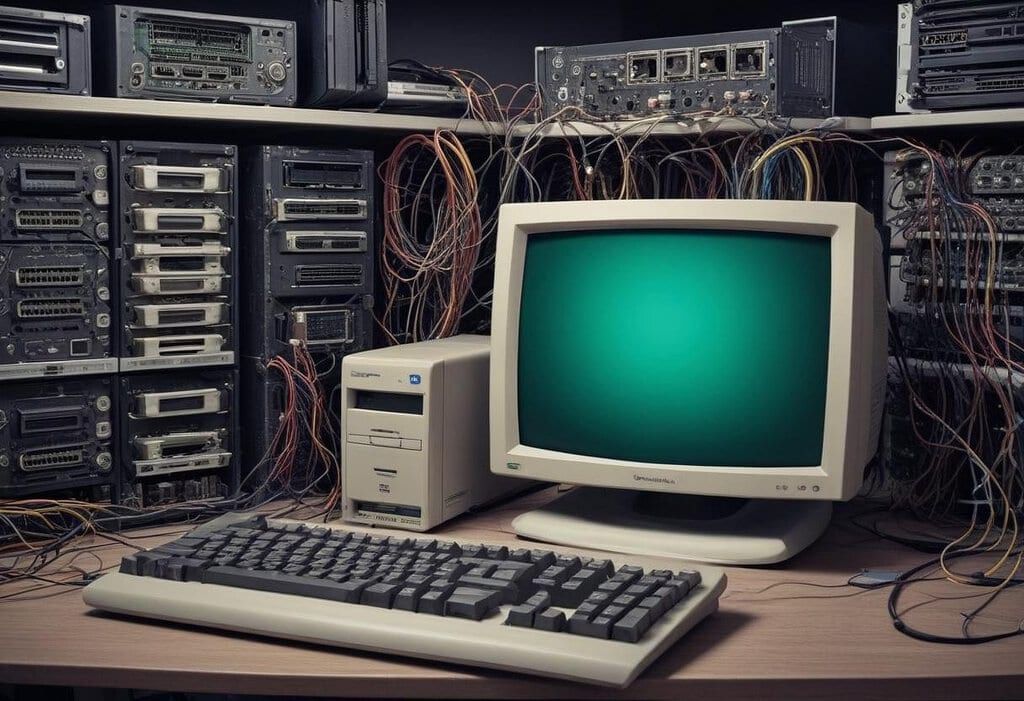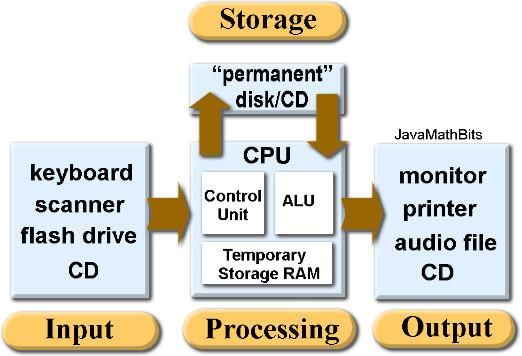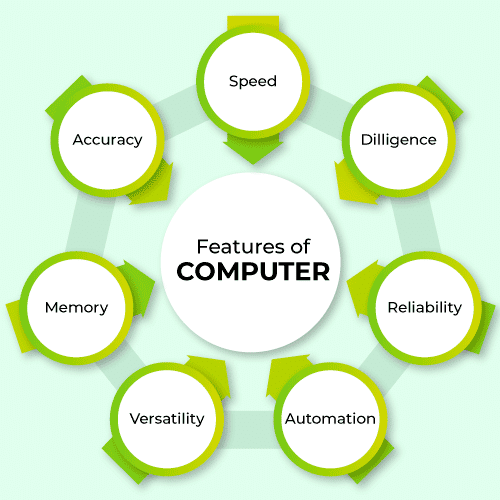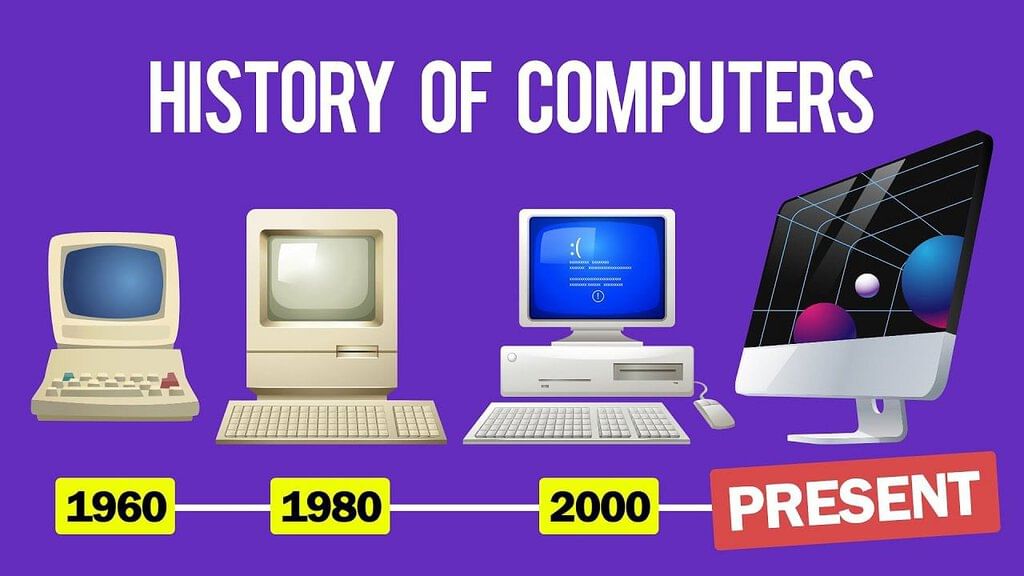Computer: Introduction, History, Generations and Types | IBPS PO Prelims & Mains Preparation - Bank Exams PDF Download
| Table of contents |

|
| Introduction |

|
| History of Computer Evolution |

|
| Generations of Computer |

|
| Classification of Computer |

|
| Features of Computers |

|
| Applications of Computers |

|
Introduction
Understanding the basic functions and components of a computer is important for SSC exams because it forms the foundation of many tasks you will perform in various job roles. From basic data entry to complex data analysis, knowing how computers work allows you to use them more effectively and efficiently. Moreover, computer literacy is a key skill that is often tested in competitive exams and is essential in today’s digital world.
What is a Computer?
A computer is an electronic device that takes data from the user, processes this data by performing calculations and operations, and then produces the desired output. The word "computer" comes from the Latin word "computare," which means "to compute."

Basic Functions of a Computer System
A computer performs four basic functions:
- Input: This is the information or data that is entered into the computer. For example, typing on a keyboard or clicking with a mouse. The data is sent to the Central Processing Unit (CPU).
- Processing: This is the series of actions the computer takes to convert the input data into meaningful information. This can include calculations, comparisons, or decision-making processes.
- Output: This function makes the processed data available to the user. For example, displaying text on a screen or printing a document.
- Storage: This involves storing data and programs permanently. For example, saving a file on a hard drive so it can be accessed later.
History of Computer Evolution
 Abacus (Invented in China, 16th Century)
Abacus (Invented in China, 16th Century)
- Characteristics: The abacus is known as the first mechanical calculating device. It uses a set of beads to represent units, with a horizontal rod indicating the ones, tens, hundreds, etc.
- Applications: The abacus was primarily used for addition and subtraction operations, and it also allowed for the calculation of square roots.
Napier's Bones (Invented by John Napier in 1617)
- Characteristics: This device has a three-dimensional structure that holds numbers from 0 to 9. It represents the graphical structure of calculation results.
- Applications: Napier's Bones were used to perform multiplication on numbers. The technology used for this device is called Rabdologia, and operations were performed on embedded rods.
Pascaline (Invented by Blaise Pascal in 1642)
- Characteristics: Pascaline is considered the first mechanical adding machine. It has a rectangular box structure with eight discs representing the number of units.
- Applications: The Pascaline was used to perform addition and subtraction of two numbers and was designed considering the pressure of liquid.
Card of Holes for Weaving Pattern (Invented by Joseph Jacquard in 1801)
- Characteristics: This was the first mechanical loom that used a punched card for the sequence of operations and mainly weaved a silk-based pattern.
- Applications: The invention simplified the process of textiles.
Analytical Engine (Invented by Charles Babbage, 1834-71)
- Characteristics: To program the machine, it used two-punched cards. It is considered the first general-purpose computer with stored programs in the form of 'pegs' called barrels.
- Applications: The analytical engine was generally used for basic arithmetic operations and could represent numbers using signs and magnitude.
Tabulating Machine (Invented by Herman Hollerith in 1880)
- Characteristics: This machine used punched cards with round holes and read one card at a time. It is the first electromechanical machine.
- Applications: It was designed to process data for the census in 1890.
MARK-I (Invented by Howard Aiken in 1944)
- Characteristics: The MARK-I consisted of interlocking panels of small glass, counters, switches, and control circuits, with data entered manually.
- Applications: Mainly used during World War II for war efforts, with magnetic drums used for storage.
ENIAC (Invented by JP Eckert and JW Mauchly in 1950)
- Characteristics: ENIAC is a combination of twenty accumulators that can trigger different operations.
- Applications: It was the first electronic digital computer used for weather prediction, atomic energy calculations, and other scientific uses.
EDSAC (Invented by John Von Neumann, 1946-52)
- Characteristics: EDSAC was the first computer to provide storage capacity, capable of storing instructions and data in memory, and could also calculate squares and a list of prime numbers.
- Applications: The first computer program was run on this machine, using mercury delay lines for memory and vacuum tubes for logic.
UNIVAC (Invented by Eckert and JW Mauchly in 1951)
- Characteristics: The UNIVAC was the first general-purpose electronic computer with a large amount of input and output, performing both numeric and textual tasks.
- Applications: It used magnetic tapes as input and output.
IBM-650 Computer (Invented by IBM Company in 1954)
- Characteristics: This computer provided input/output units converting alphabetical and special characters to a two-digit decimal code.
- Applications: It was used for payroll processing, oil refinery design, and market research analysis.
Generations of Computer
Let us now discuss the development in Computer Technology over the different generations.

First Generation
- The era between 1940 and 1956 marks the initial phase of computer development.
- First-generation computers were built using vacuum tubes or thermionic valves.
- These computers utilized punched cards and paper tape for input, while output was in printed form.
- They operated on a binary-coded language, represented by 0s and 1s. Examples include ENIAC and EDVAC.
Second Generation
- The time period from 1956 to 1963 is generally known as the era of Second Generation Computers.
- Transistor technology was used to create the second generation computers.
- Second generation computers were smaller than the first generation ones.
- Computers in the second generation took less time for calculations compared to the first generation.
Third Generation
- The time period from 1963 to 1971 is often known as the Third Generation of computers.
- Third generation computers were created using Integrated Circuit (IC) technology.
- Compared to second generation computers, third generation computers were smaller in size.
- When compared to second generation computers, third generation computers were faster in processing data.
- Third generation computers consumed less power and produced less heat.
- The maintenance expenses for third generation computers were lower.
- The computer systems in third generation computers were more user-friendly for business purposes.
Fourth Generation
- The era from 1972 to 2010 is often seen as the fourth phase of computers.
- Fourth phase computers were made using microprocessor technology.
- With the fourth phase, computers became quite small and easy to carry around.
- These fourth phase machines produced very little heat.
- They were faster and more reliable in terms of accuracy.
- The cost of making them reduced significantly compared to earlier versions.
- They became accessible to the general public.
Fifth Generation
- The era from 2010 until now and moving forward is commonly known as the fifth generation of computers.
- Earlier, computer generations were distinguished mainly by their hardware, but the fifth generation introduced a focus on software as well.
- Fifth generation computers were known for their substantial capabilities and extensive memory storage.
- Tasks performed on these computers were swift, and they could handle multiple operations at once.
- Noteworthy technologies of the fifth generation encompass Artificial Intelligence, Quantum Computing, Nanotechnology, Parallel Processing, and more.
Classification of Computer
Computers can be classified into 3 Categories as follows: 
Types of Computers Based on Size
1. Microcomputer
Microcomputers are the least powerful but the most widely used and fastest growing type of computers. They are also known as portable computers. They consist of three basic categories of physical equipment: the system unit, input/output devices, and memory.
Types of Microcomputers:
- Desktop Computer or Personal Computer (PC): These are small, relatively inexpensive computers based on microprocessor technology (Integrated Circuit). They are used for various personal and business applications.
- Notebook: Also known as laptops or ultrabooks, these are portable and lightweight, designed to fit into briefcases. They include a rechargeable battery, making them usable anywhere. Laptops were developed by Alan Kay.
- Handheld Computers or Palmtops: These are very small computers designed to fit into the palm of your hand. They are practical for certain functions such as phone books and calendars and use a pen for input instead of a keyboard.
- Tablet Computer: Tablets have the key features of notebooks but accept input from a pen instead of a keyboard or mouse.
- Smartphones: These are cellular phones that function both as a phone and a small PC. They may use a pen or have a small keyboard and can connect to the internet wirelessly. Examples include Apple, Blackberry, and Nokia smartphones.
2. Mainframe Computer
Mainframe computers have large internal memory storage and a comprehensive range of software. They serve as the backbone for the entire business world, allowing many people to work simultaneously. Mainframe computers include IBM-370, IBM-S/390, and UNIVAC-1110.
3. Minicomputer
Minicomputers are smaller, faster, and cost less than mainframe computers. Initially designed for specific tasks like engineering and Computer-Aided Design (CAD) calculations, they are now used as central servers. Examples include IBM-17, DEC PDP-11, and HP-9000.
4. Supercomputer
Supercomputers are the fastest and most expensive machines with high processing speeds compared to other computers. Their speed is measured in FLOPS (Floating Point Operations Per Second). They are used for complex tasks like weather forecasting, scientific simulations, and cryptography.
Types of Computers Based on Working System
1. Analog Computer
Analog computers are job-oriented, performing arithmetic and logical operations by manipulating and processing data. They use continuous variables for mathematical operations and include devices like speedometers and seismographs.
2. Digital Computer
Digital computers work by calculating binary digits. They perform mathematical problems and produce desired graphics and sounds. Examples include desktop PCs.
3. Hybrid Computer
Hybrid computers combine the features of analog and digital computers. They are used in specialized applications like hospitals for ECG and DIALYSIS machines.
Types of Computers Based on Purpose
1. General Purpose Computer
General-purpose computers are designed to solve various problems by changing the program or instructions. They are used for tasks like small database calculations and accounting.
2. Special Purpose Computer
Special-purpose computers are designed to solve a single, dedicated type of problem. Examples include automatic aircraft landing systems and multimedia computers.
Features of Computers

1. Speed
Computers can process data very quickly, handling millions of instructions per second. This high processing speed allows for efficient performance of complex tasks in a short amount of time.
2. Accuracy
Computers provide a high degree of accuracy. They execute instructions without errors, provided the input and instructions are correct. This makes them reliable for tasks requiring precision.
3. Storage Capacity
Computers can store a vast amount of data. The storage capacity depends on the size of the hard disk or other storage media. This feature allows users to save large volumes of information for future use.
4. Versatility
Computers can perform different types of tasks simultaneously. This versatility allows them to handle various applications and processes at the same time, making them useful in multitasking environments.
5. Plug and Play
Computers have the ability to automatically configure new hardware and software components. This feature simplifies the process of adding new devices or software, making it user-friendly.
6. Diligence
Unlike humans, computers do not suffer from fatigue, lack of concentration, or monotony. They can work continuously for long periods without making errors, ensuring consistent performance.
7. Secrecy
Computers enhance the security of information by implementing login systems with password protection. This reduces the risk of unauthorized access and leakage of sensitive information. Examples include ATM counters and email systems.
Applications of Computers
Nowadays, computers are used in almost every aspect of professional and personal life. Here are some key areas where computers play a vital role:
 1. Education
1. Education
Computers have become excellent teaching tools. Educational institutions use computers in various ways, such as tele-education, virtual classrooms, and online classes, enhancing the learning experience.
2. Science
Scientists have long utilized computers for research and experiments. A modern development is the concept of a "collaboratory," an internet-based collaborative laboratory where researchers worldwide can work together easily, even from different locations.
3. Industry
In the industrial sector, computers are essential for controlling manufacturing systems and ensuring the continuous operation of machinery. Parameters like temperature, pressure, and volume are monitored and controlled by computers. Robotics, powered by computers, play a crucial role in enhancing industrial processes.
4. Recreation and Entertainment
Computers have significantly impacted entertainment and leisure activities. They are used in video games, virtual reality experiences, digital media, and more.
5. Government
Various government departments use computers for planning, control, and law enforcement activities. Computers help in managing data, improving efficiency, and facilitating decision-making processes.
6. Health
Computers are indispensable in the healthcare sector. They are used for scanning, X-rays, telemedicine, patient monitoring, maintaining patient records, diagnosis, and other medical procedures, improving the overall quality of healthcare services.
7. Multimedia
In multimedia, computers are used to integrate text, graphics, drawings, animation, audio, and other media types. They allow for the digital representation, storage, transmission, and processing of information.
8. Banks
Computers are widely used in banks to maintain customer account records, manage transactions, provide online banking services, and ensure the security of financial data.
9. Business
Computers play a crucial role in business by using a wide range of business software. These tools help a company's marketing division to produce sales forecasts, devise new strategies, and manage various business operations efficiently.
10. E-Commerce
E-commerce refers to the exchange or buying and selling of goods and services over the internet. It involves the exchange of money and sometimes the transportation of goods. When this electronic commerce occurs between businesses, it is known as business-to-business or B2B.
11. Publication
Computers have revolutionized the publication process. They simplify creating different parts of a publication, such as text, illustrations, and graphics. Without computers, these components would need to be created individually and then manually cut and pasted to form a page layout. Computers enable a more efficient and streamlined process, making it easier to produce high-quality publications.
These applications highlight the extensive use of computers across various fields, enhancing efficiency, productivity, and the ability to innovate.
|
541 videos|681 docs|263 tests
|
FAQs on Computer: Introduction, History, Generations and Types - IBPS PO Prelims & Mains Preparation - Bank Exams
| 1. What are the components of a computer? |  |
| 2. How has the computer evolved over time? |  |
| 3. What are the different generations of computers? |  |
| 4. How are computers classified? |  |
| 5. What are some common applications of computers? |  |

 Abacus (Invented in China, 16th Century)
Abacus (Invented in China, 16th Century)















